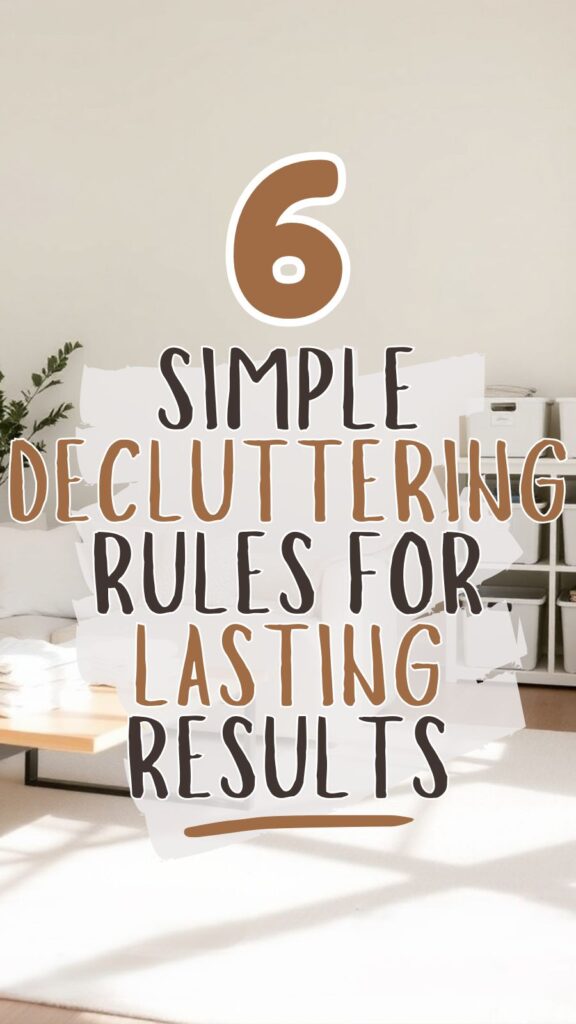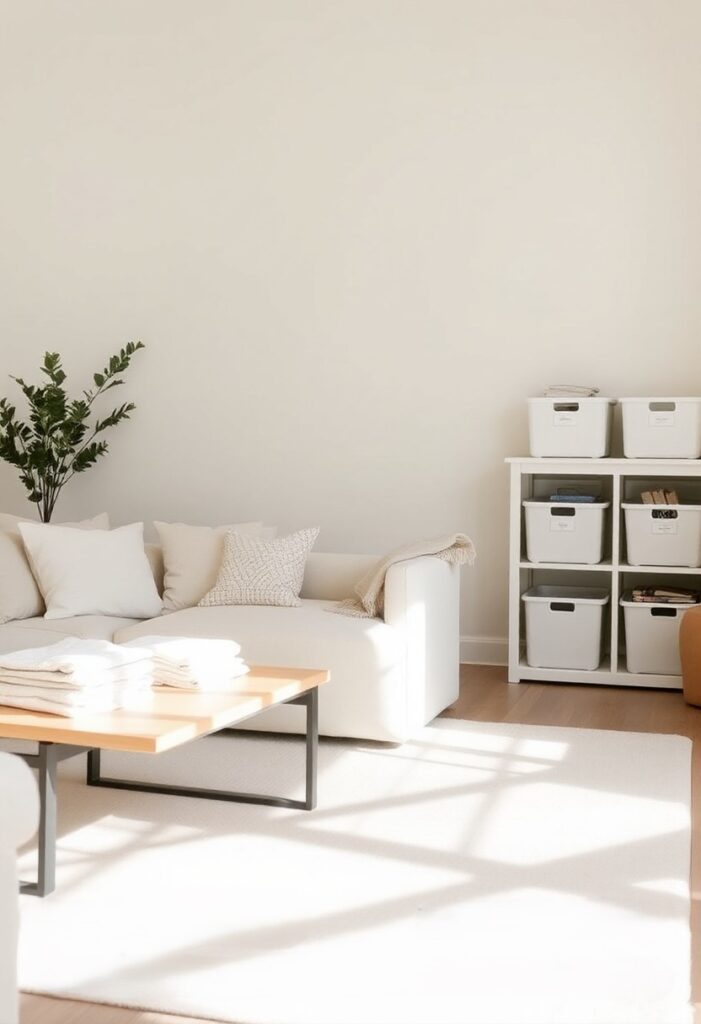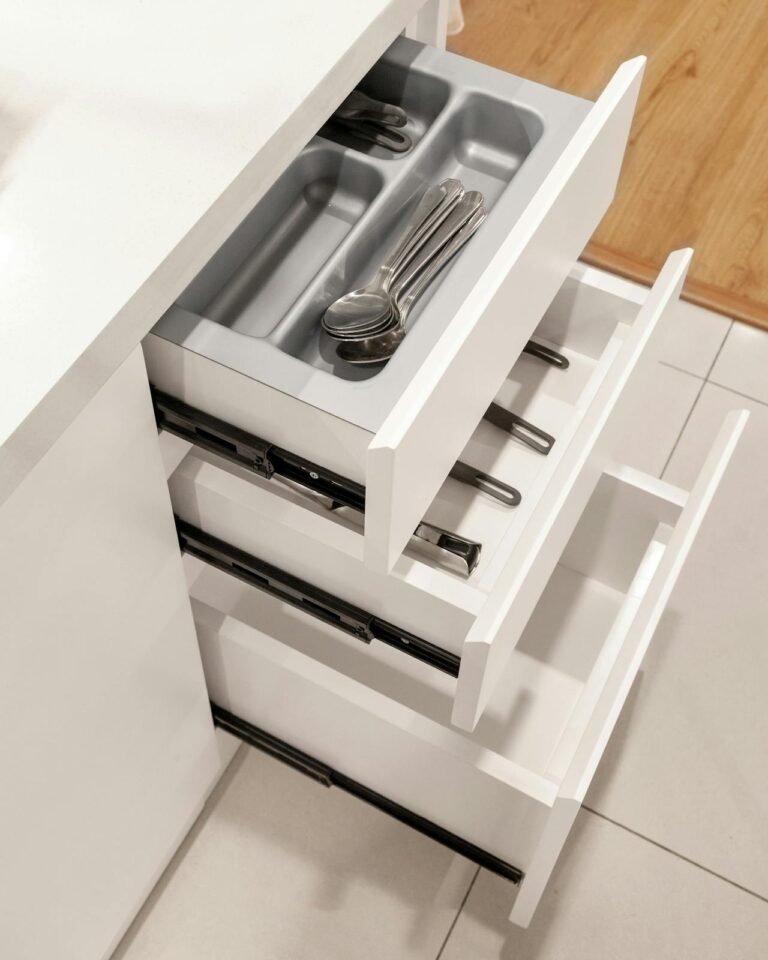You’ve probably tried decluttering before. Maybe you spent a weekend tackling that overflowing closet or finally sorted through those kitchen drawers, only to find yourself back at square one three months later. The clothes are piling up again, the counters are covered with random items, and you’re wondering why your best decluttering efforts never seem to stick.
Here’s the truth: sometimes, decluttering advice focuses on the “what” (get rid of stuff) without addressing the “how” (sustainable systems that actually work). The result? You end up in a cycle of organizing, re-organizing, and feeling frustrated when clutter creeps back in.
This guide will walk you through six decluttering rules that create lasting change. These aren’t just one-time purging strategies – they’re sustainable habits that will keep your space organized for years to come.
What You’ll Need Before Starting

Before diving into the rules, gather these simple tools:
- 3 boxes or bags labeled “Keep,” “Donate,” and “Trash”
- Timer (your phone works perfectly)
- Notebook or phone app for quick notes
- Camera to take “before” photos (optional but motivating)
- Cleaning supplies for a quick wipe-down after decluttering
That’s it. You don’t need expensive organizing systems or fancy containers. In fact, buying storage solutions before decluttering is one of the biggest mistakes people make.
Rule 1: The One-Touch Decision Method
How It Works
When you pick up an item during decluttering, you must make a decision about it immediately – no setting it aside to “think about later.” This prevents the endless shuffling of items that keeps you stuck.
Step-by-Step Process
- Pick up one item at a time
- Ask yourself: “Have I used this in the past year?”
- If yes: Does it have a designated home? If not, assign one now
- If no: Does it have significant sentimental value or future necessity?
- Make your choice: Keep (and assign a home), donate, or trash
- Place it in the appropriate box immediately
Why This Works
Decision fatigue is real. The more times you handle the same item without deciding, the more mentally exhausted you become. The one-touch method forces quick, confident decisions that you can trust.
Read More: 7 Clever Ways to Use the Space Behind the Sofa
Rule 2: The Container Limit System
The Core Principle
Every category of items gets exactly one designated container or space. When that space is full, you must remove something before adding anything new.
How to Implement
Choose your containers first:
- One drawer for batteries, chargers, and small electronics
- One basket for mittens, hats, and scarves
- One shelf section for books you’re currently reading
- One bin for craft supplies
Set the boundary: When the container is full, it’s full. No overflow allowed.
Apply the one-in-one-out rule: New book comes in? An old one must go out.
Real-World Example
Sarah designated one medium basket for her daughter’s hair accessories. When the basket got full, her daughter had to choose which old scrunchies to donate before adding new ones. Result? No more overflowing bathroom drawers, and her daughter learned to value what she kept.
Rule 3: The 15-Minute Daily Reset
Why Daily Maintenance Matters
Clutter accumulates gradually, so prevention works better than periodic major cleanouts. Spending 15 minutes daily maintaining your space prevents the overwhelming buildup that leads to decluttering burnout.
Your Daily Reset Routine
Set a timer for 15 minutes and focus on:
- Return displaced items to their designated homes (5 minutes)
- Process paperwork – file, act on, or toss (5 minutes)
- Clear one surface completely – kitchen counter, coffee table, or desk (5 minutes)
Making It Stick
- Pick the same time daily – after dinner, before bed, or first thing in the morning
- Start smaller if needed – even 5 minutes makes a difference
- Focus on progress, not perfection – some days you’ll only manage 10 minutes
Read More: How to Customize Rental Living Room With Textiles
Rule 4: The Sentimental Item Strategy
The Challenge
Sentimental items are often the most challenging to declutter. These are the items that hold precious memories and emotional connections, making it difficult to part with them even when they’re taking up valuable space.
The Strategic Approach
Create sentimental boundaries:
- Choose one memory box per family member or life phase
- Take photos of bulky sentimental items before donating
- Keep the best representatives – one meaningful item instead of multiple similar ones, your favorite piece from a collection
Ask better questions:
- “Does keeping this honor the memory, or am I keeping it out of guilt?”
- “If I moved tomorrow, would I pack this?”
- “Am I keeping this for me, or because I think I should?”
The Photo Documentation Method
Before letting go of sentimental items that take up space, photograph them. Create a digital album called “Memories” on your phone. You preserve the memory without the physical storage burden.
Rule 5: The Category Completion Rule
Stop Room-by-Room Decluttering
Instead of decluttering room by room, declutter by category. Gather all items of the same type from throughout your house before making decisions.
How to Apply Category Decluttering
Week 1: Clothing
- Gather all clothes from every room, closet, and laundry basket
- Sort into keep, donate, and trash piles
- Put back only what you’re keeping
Week 2: Books
- Collect all books from every room
- Keep only books you’ll reference or reread
- Donate the rest to libraries or schools
Week 3: Kitchen items
- Group similar items (all mugs, all cooking utensils, all gadgets)
- Keep only what you actually use
Why This Works Better
When you see all your sweaters together, it’s obvious you have too many. When they’re scattered across three closets, you don’t realize the extent of the accumulation.
Also Read: How to Blend Old and New in Your Living Room Decor
Rule 6: The Designated Home Rule
Every Item Needs an Address
The reason clutter accumulates is simple: items don’t have designated homes, so they get set down wherever is convenient at the moment.
Creating Effective Homes for Items
Make homes obvious and accessible:
- Keys go in a bowl by the front door (not in a drawer)
- Remote controls have a basket on the coffee table
- Important papers have a desktop file folder
Follow the 30-second rule: If it takes longer than 30 seconds to put something away, the system won’t work consistently.
Label everything initially: Even adults benefit from labels while building new habits. Remove them once the routine is established.
The Launch Pad Concept
Create “launch pads” near entrances for items that come and go frequently:
- Hooks for coats and bags
- A small table for keys and sunglasses
- A shoe rack or basket
Common Decluttering Mistakes to Avoid
Mistake 1: Buying Storage Solutions First
Many people rush to buy cute baskets and organizing systems before decluttering. This leads to organized clutter – you still have too much stuff, it’s just in prettier containers.
Instead: Declutter first, then assess what storage you actually need.
Mistake 2: Trying to Declutter Everything at Once
Weekend decluttering marathons lead to exhaustion, poor decisions, and eventual backsliding.
Instead: Focus on one category or area per week. Sustainable progress beats overwhelming yourself.
Mistake 3: Not Involving Family Members
If you share your space, decluttering alone won’t work long-term. Family members need to understand and participate in the new systems.
Instead: Involve everyone in creating household rules and designated homes for shared items.
Also Read: 8 Living Room Reset Tasks to Create a Calm Space
Troubleshooting When Things Don’t Go as Planned
“I Can’t Decide What to Keep”
Try the 6-month box method: Put questionable items in a box. If you don’t need anything from it in 6 months, donate the entire box without opening it.
“My Family Members Aren’t Following the New Systems”
Start with common areas everyone uses like the kitchen or living room. Once they see how much better these spaces function, they’ll be more willing to apply the same principles to their personal spaces.
Make it easier to do the right thing than the wrong thing: If shoes pile up by the door, put a shoe rack there instead of expecting people to carry them upstairs.
“I Keep Buying More Stuff”
Implement a 24-hour waiting period for non-essential purchases. Often, the desire passes.
Before buying anything, identify exactly where it will live in your home. If you can’t name the specific spot, don’t buy it.
“The Clutter Comes Back Quickly”
You probably skipped the “designated homes” step. Go back and assign a specific location for every item you decided to keep. Things return to clutter when they have nowhere to belong.
Setting Realistic Expectations

Timeline for Real Results
- Week 1-2: You’ll see immediate visual improvements but may feel overwhelmed by decisions
- Week 3-4: Decision-making gets easier and faster
- Month 2-3: New habits start feeling natural
- Month 6: Systems become automatic, and you’ll notice when things are out of place
What Success Actually Looks Like
Success doesn’t mean magazine-perfect spaces. It means:
- You can find what you need quickly
- Surfaces stay relatively clear with minimal effort
- Putting things away feels automatic
- You feel calm and in control in your space
What May Remain Imperfect
- You’ll still accumulate some clutter – that’s normal
- Family members may take longer to adopt new systems
- Seasonal items (sporting equipment, seasonal clothing) may need periodic re-evaluation
- Life changes (new baby, job change) will require system adjustments
Also Read: 16 DIY Home Aesthetic Projects That Instantly Elevate Your Space
Pro Tips for Decluttering Success
Start with Easy Wins
Begin decluttering in areas where decisions are obvious – expired medications, broken items, or clothes that don’t fit. Early success builds momentum for harder decisions later.
Use the “Would I Purchase This Today?” Test
If you wouldn’t buy an item today at full price, you probably don’t need to keep it.
Take Photos of Your Progress
Before and after photos are incredibly motivating. Take them even for small areas like a single drawer – you’ll be amazed at the visual difference.
Create a Donation Station
Keep a designated box or bag in a convenient location for items you decide to donate throughout the week. When it’s full, immediately put it in your car to drop off.
Schedule Seasonal Check-ins
Set phone reminders for seasonal decluttering sessions:
- Spring: Winter clothes and outdoor items
- Summer: School supplies and winter gear
- Fall: Summer clothes and outdoor equipment
- Winter: Summer gear and outdoor items
Involve Kids Age-Appropriately
- Ages 3-6: Help them sort toys into “love it” and “someone else would love it” piles
- Ages 7-12: Give them ownership of their own spaces with clear guidelines
- Teens: Respect their autonomy while maintaining common area standards
Moving Forward: Your Decluttered Life
You now have six proven rules that will transform not just your space, but your relationship with your belongings. Remember, decluttering isn’t a one-time event – it’s a new way of living that gets easier with practice.
Start with Rule 1 (One-Touch Decisions) this week. Master that before moving to Rule 2. By the time you’ve implemented all six rules, maintaining a clutter-free home will feel as natural as brushing your teeth.
Your Next Steps
Once your decluttering systems are working smoothly, you might want to tackle related challenges:
- Creating efficient morning and evening routines
- Organizing important paperwork and documents
- Developing sustainable cleaning schedules
- Teaching kids to maintain their own organized spaces
The skills you’ve learned here – making quick decisions, creating designated homes, and maintaining daily systems – will serve you well in all these areas.
Your clutter-free life starts with your next decision. Pick up one item, apply the one-touch rule, and begin building the sustainable systems that will keep your home organized for good.



